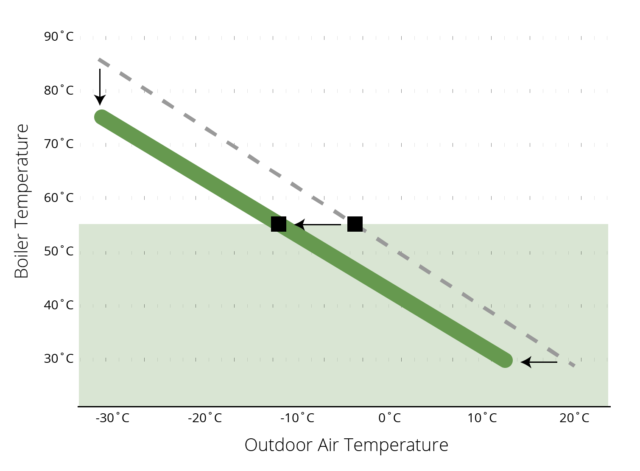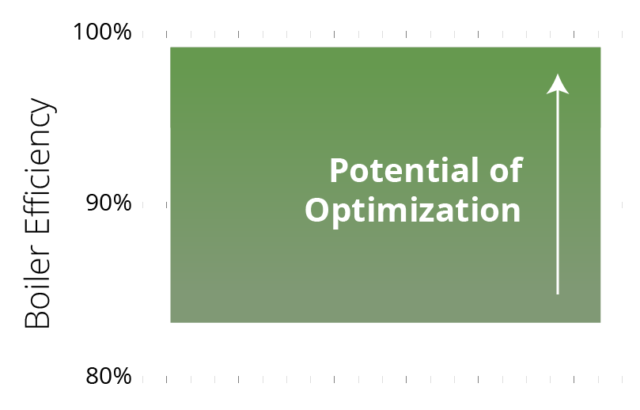Optimizing your condensing boilers in your school or institutional facilities will save energy, money and maintenance time. In fact, ongoing optimization and maintenance can improve the efficiency of condensing boilers to upwards of 98%. Considering that many condensing boiler systems barely achieve 90% efficiency, optimization is an investment that quickly pays off.
Here are the mechanics behind condensing boilers and our top tips to optimize the condensing boilers in your school facilities.
Condensing boiler basics

The efficiency of conventional boilers is around 70 to 80% and the efficiency of condensing boilers is around 90%.
Boilers are simple heat exchange systems where fuel is combusted and the heat is transferred into water. Fuel combustion heats up air in the burner chamber and releases hot carbon-based gases and water vapour. In the heat exchanger, heat from this mixture of hot gases is transferred to the water as the gases travel to escape the boiler system. Even with large heat exchangers, around 20 to 30% of the heat escapes with the flue gases and water vapour.
To capture this escaping heat, the hot flue gases pass by a secondary heat exchanger and are allowed to cool. The vast majority of heat is transferred and the gases turn into liquids as they cool. That’s the condensing part.
The secondary heat exchanger has multiple benefits. Firstly, it preheats the intake water before the water passes through the main heat exchanger, meaning the water requires less heat to get to the target temperature. Secondly, intake gases are also heated as they enter the burner chamber. This preheats the air before it is combusted. Both preheating processes contribute to the efficiency of the boiler.
Considering that a condensing boiler just adds one additional step, why can’t conventional boilers be outfitted into a condensing boiler? The challenge is the condensate – it is an acidic liquid that damages conventional boiler materials. With a condensate pH of around 3 to 5, heat exchangers need to be made out of stainless steel, aluminum alloys or plastics (for low-heat condensing boilers).
Peak efficiency around 98%
There will always be some heat loss, but an optimized condensing boiler system is expected to achieve 98% efficiency. In reality, many condensing boiler systems barely go above 90%.
Efficiency drastically declines when condensation barely (or doesn’t at all) occur. Condensation begins when the boiler temperature is below 55˚C – if the gases pass through the both the primary and secondary heat exchangers at high temperatures, little condensation occurs. Heat escapes the system with the gases and water vapour. The lower the condensate temperature means more heat has been transferred in the heat exchanger, with 99% efficiency occurring when the temperature goes under 25˚C.
The main factor that impacts the temperature of the condensate is the temperature setpoint of the hot water in the boiler. A higher boiler temperature means the flue gas temperature will be higher. If the gases are too hot, the gases will not be able to cool and condensation will not occur.
Not all scenarios allow for the flue gases to cool and condensate. Boilers set to high temperature heat the air to temperatures that are not capable of condensing within the heat exchangers. And cold intake air temperatures require the boiler to operate at higher temperatures to sufficiently heat buildings. As a result, few condensing boilers operate at peak efficiency all the time.
The best you can do is optimize your condensing boiler for your buildings, climate and heating systems.
Optimizing your condensing boilers
Design
Condensing boilers perform at peak efficiency at cooler temperatures because more condensation can occur. Designing an entire system that runs on cooler water will maximize the efficiency of the boiler. Here are a few ideas for your systems to adapt to cooler water:
- Install more coils in the air handling units to increase the surface area for heat transfer.
- Optimize terminal devices (like radiators and reheat coils) to run on the lowest temperature possible.
- Oversized heat exchangers and on-ground radiators allow for more heat transfer so the boiler can run at lower temperatures.
- In-ceiling radiant panels require high temperature so they adapt poorly to a cooler water system, however return water from the radiant panels can pass through reheat coils to reduce water temperature before returning to the boiler.
Smaller boilers are better. Instead of installing one large boiler that meets the needs of the most extreme heating expected, install several smaller boilers in sequence. Individual boilers can be turned off when demand is lower. It is better for one smaller boiler to be continuously on instead of one large boiler to be cycles between on and off.

The efficiency of a condensing boiler significantly improves when return water temperature is below 55 degrees. For every temperature reduction of ~ 5 degrees, the efficiency improves around 1 per cent.
Calibration
Old boilers used to run at one temperature. When heating was required, the boiler would turn on and run on the highest setting until the air temperature setpoint was met. Not surprisingly, this was highly inefficient. With modulating burners, water temperature controls and outdoor air temperature sensors, the optimal water temperature can be achieved. This means the water temperature can be the lowest temperature possible to meet the system’s demands but allow for condensation when possible.
The goal is to lower the boiler water temperature to as low as possible but still meet demand. Lower temperature boilers may have to be on longer to meet the system’s demands, but the improvements in efficiency outweigh the additional time the boiler is on. Lower boiler temperatures reduce the temperature of the flue gases and more condensation will be allowed to happen.
Here are a few approaches to optimize the boiler’s temperature:
- Determine the part of the building that demands the highest water temperature. After lowering the boiler temperature, monitor that space to ensure demand is satisfied.
- The shoulder season (autumn and spring) is a great time of year to lower the boiler temperature – outdoor air temperature tends to not be extremely hot or cold.
- Lower boiler temperature when the building is not occupied, especially over breaks.
- Smart controls allow the boiler’s temperature to respond to occupancy, demand and outdoor air temperature.
- After every retrofit or change in the system, review the boiler’s temperatures and try to lower.
Monitoring combustion gives us insight into burner operations. Combustion requires air but too much will lead to energy being wasted and too little will cause incomplete combustion. The goal is a clean and complete burn – carbon dioxide should be between 8 and 10% while carbon monoxide should be below 20 ppm. Adjust the airflow and monitor with combustion analyzers to find the optimal airflow values.

Condensation can occur when the boiler temperature is below 55 degrees. In this sample system, the boiler can meet demand and condense when outdoor air temperature is above ~ 0 degrees.

There are two ways to increase the amount of time the boiler can condense. Lower the maximum boiler temperature and adjust the controls so the boiler operates at lower temperatures when the outdoor air temperature is warmer.
Every degree matters
Optimizing a condensing boiler is the process of adjusting the boiler’s temperature to be a low as possible while still meeting demand. Every degree matters. Although the process to optimize a boiler is an ongoing process, the improvements in efficiency mean tangible reductions in energy consumptions and costs.
Do you have a condensing boiler that is not as efficient as expected? Follow the tips to get the temperature as low as possible. And if you still aren’t achieving your target efficiency, send us a message – we would be happy to review your system to save energy and money.

